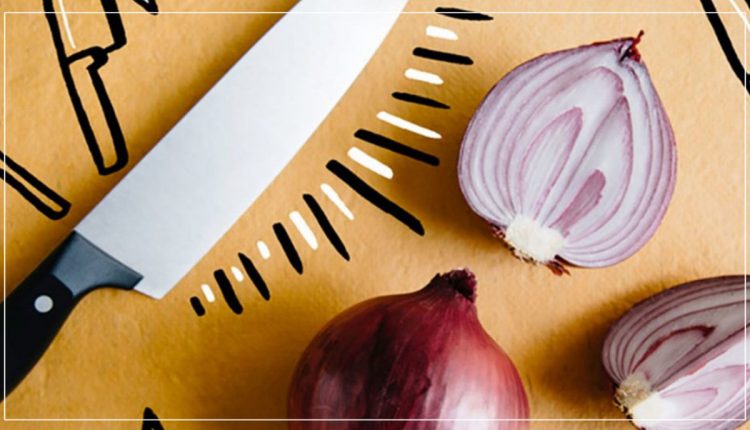
How to Cut an Onion Without Crying
Unless you’ve spent most of your life avoiding cooking, you’re probably familiar with the burning and tearing sensations that come part and parcel with slicing onions. Onions contain naturally occurring, amino acids called sulfoxides. These sulfur compounds are responsible for their tangy, pungent flavor. Cutting onions damages their cell walls and results in the conversion of sulfoxides to syn-propanethial-s-oxide—a highly volatile compound that reacts with the water in your eyes to form sulfuric acid. The acid irritates your eyes, causing them to burn and produce more tears to wash the acid away. Luckily, there are several ways of preventing this from happening.
How to Cut Onion Without Crying:
1. Freeze the Onion
Placing the onion in the freezer for fifteen minutes before chopping is sure to reduce irritation. The conversion of sulfoxides to syn-propanethial-s-oxide is an enzyme controlled process. Enzymes become inactive at low temperatures. Thus, freezing, or even refrigerating onions will help reduce the amount of irritant chemical released. This process will have no effect on the taste of your food, but freezing may harden the onions, making them more difficult to cut.
Beware that leaving onions in the fridge for too long (over 20 or so minutes) may cause odors to linger in your fridge which can be absorbed by other foods.
2. Cut the Onion Under Water
Simply place the peeled onion in a large bowl of water and proceed to cut the onion under the surface as usual. In this method, the sulfuric compounds released will dissolve in the water instead of diffusing through the air and entering your eyes. The downside of this is the difficulty in maneuvering the onion under the water. Make sure to use a wide, flat dish, so that you have enough space for cutting. An alternative to this method, which works according to the same principal is to place your cutting board in the sink and cut the onion under cold, running water.
In both cases, make sure to be extra careful to avoid accidentally cutting your fingers!
3. Use a Very Sharp Knife
A sharper knife will make a cleaner cut, damaging fewer onion cell walls. Thus, less syn-propanethial-s-oxide will be released.
4. Cut the Onion Under an Exhaust, Or Next to an Exhaust or Air Vent
Air currents will help carry the onion vapors in a different direction—reducing the amount of vapor that comes in contact with your eyes.
5. Wear a Pair of Air-Tight Goggles or a Face Mask
If you don’t mind looking sort of funny while cooking, this is perhaps the easiest and most effective way to protect your eyes while cutting onions. If the goggles are air-tight, it will be impossible for the irritant fumes to reach your eyes.
6. Cut Onions with a Piece of Bread in Your Mouth
The theory behind this technique is that, if you allow the bread to protrude from your mouth, it will absorb some of the onion vapors. Continuous chewing is also thought to somehow reduce the irritating effects of onion vapors. This strategy may seem bizarre and illogical, but chefs from many reputable organizations such as wikihow, prevention.com, and even Scientific American swear by it.
7. Soak the Onion in Water
Soaking peeled onions in water for about twenty minutes is believed to draw-put some of the harsh chemicals from the onion. The drawback of this technique is a slight reduction in the pungency of the onion’s flavor. Many chefs vary in their opinions about the efficacy of this method.
8. Remove the Onion Root or Cut the Root Last
Since sulfuric compounds are most concentrated in the root of the onion, you can prevent tears by simply avoiding slicing through the root. The best way to do this is to remove the root before proceeding to cut the onion. It may be difficult to maneuver the blade around the root, but special knives have now been invented for exactly this purpose.

